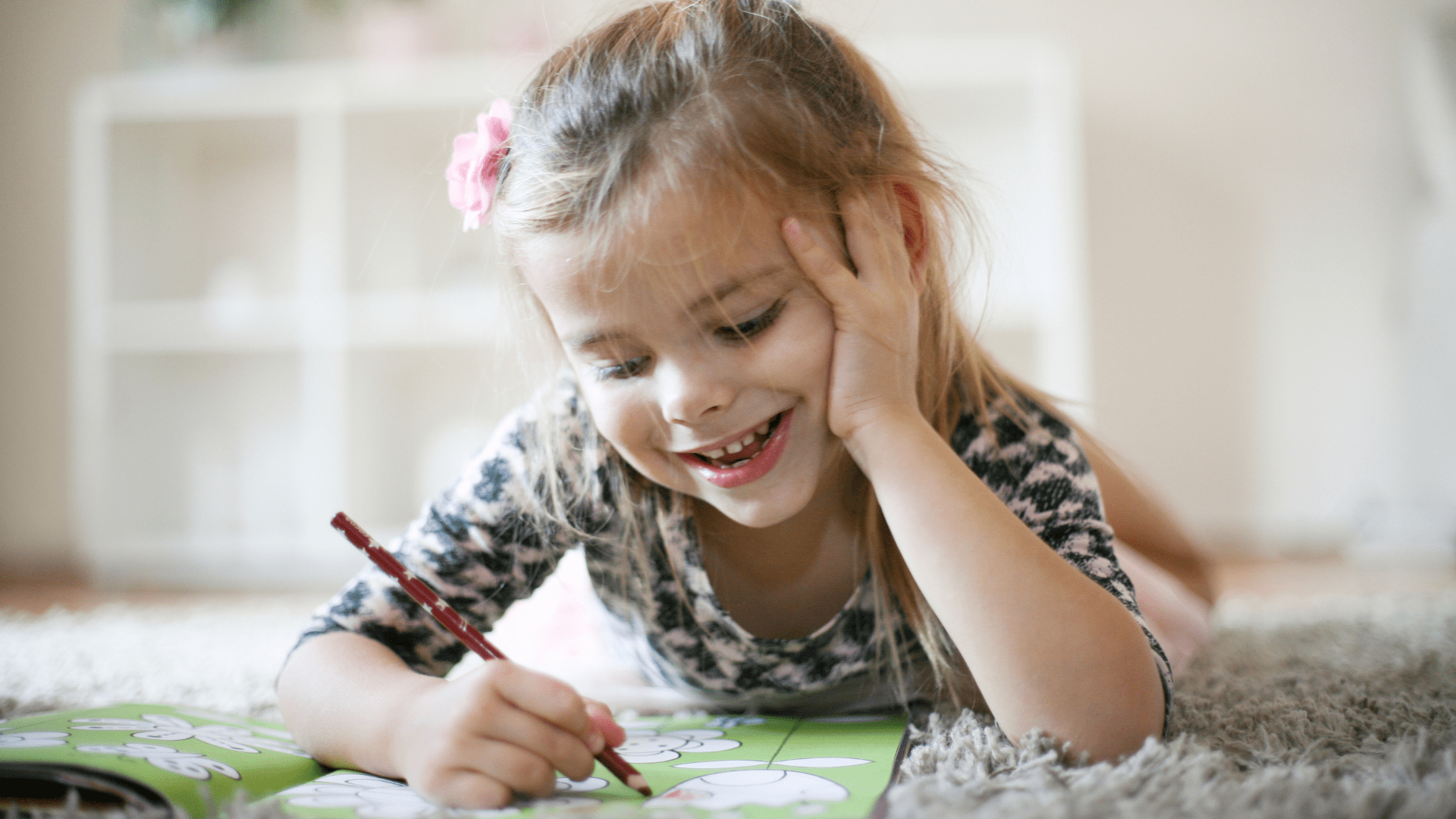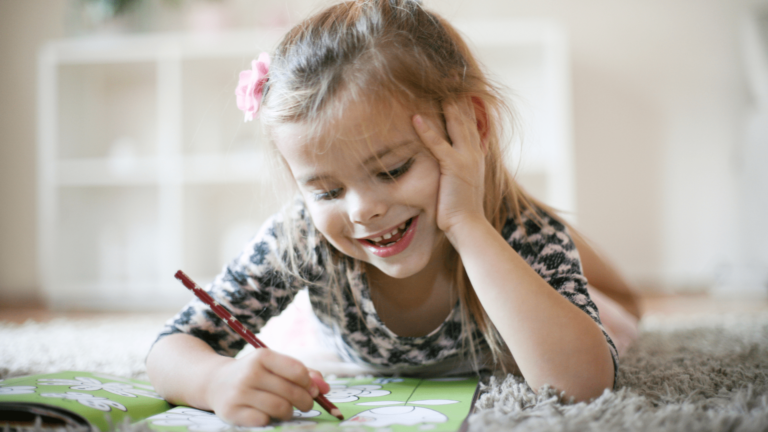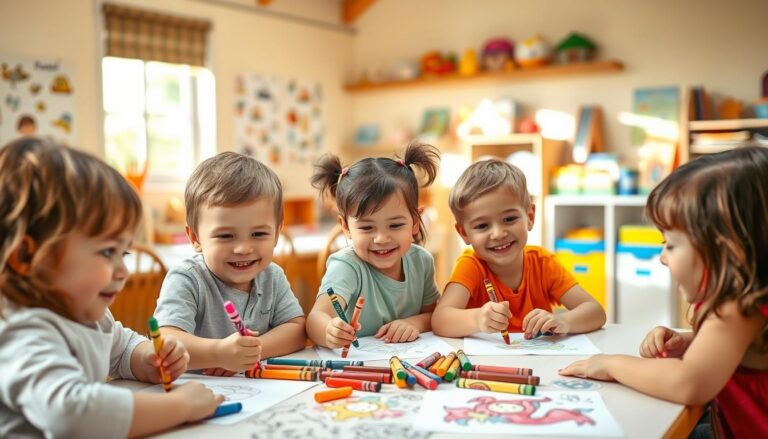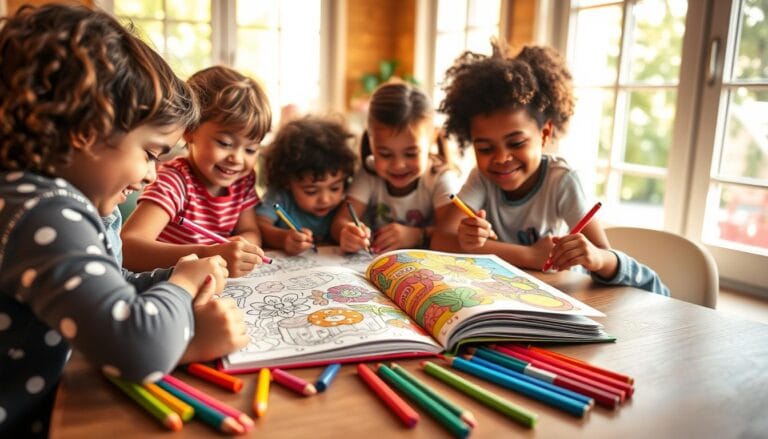Boost Your Child’s Focus and Imagination Through Coloring
Unlock Your Child’s Focus and Creativity with Coloring
Looking for a simple way to boost your child’s focus and imagination? Coloring is more than just a fun activity. It offers many benefits.

Coloring helps kids improve their fine motor skills and hand-eye coordination. It also boosts their self-expression. Plus, it greatly enhances their ability to focus and be creative.
Key Takeaways
- Coloring enhances focus and concentration in children.
- It fosters creativity and self-expression.
- Develops fine motor skills and hand-eye coordination.
- Provides a healthy outlet for emotions and stress.
- Prepares children for more complex academic tasks.
The Resurgence of Coloring as an Educational Tool
Coloring is becoming a big part of learning again. This change is thanks to new studies and ways of teaching.
Recent Studies Highlighting Coloring Benefits
Studies show that coloring activities for children boost their brains. Kids get better at focusing, being creative, and using their hands.
Why Educators Are Returning to This Classic Activity
Teachers are bringing back coloring because it’s good for kids in many ways. It helps them stay focused and ready for school.
Current Trends in Childhood Development Approaches
Today, teaching kids includes enhancing focus through coloring and other creative stuff. This way of learning values art and brain growth.
By adding coloring to school, teachers give kids a chance to learn in a fun and complete way. It helps them grow creatively and academically.
How Coloring Improves Focus and Creativity in Kids
Coloring is more than just a fun activity for kids; it’s a powerful tool for enhancing their focus and creativity. As children engage in coloring, they are developing crucial cognitive skills that benefit them beyond their artistic expression.
The Neuroscience Behind Focus Development Through Coloring
Research has shown that coloring can have a positive impact on the brain’s ability to focus. The act of coloring requires concentration, which helps strengthen the connection between neurons in the brain, leading to improved attention span over time. This neurological development is crucial for children as they grow and face more complex tasks in school and other areas of life.
Creativity Pathways Stimulated by Coloring Activities
Coloring isn’t just about staying within the lines; it’s an outlet for creativity. By choosing different colors and shading techniques, children are able to express themselves in unique ways, fostering their creative thinking. This creative expression is vital for problem-solving skills and innovative thinking, skills that are highly valued in today’s fast-paced world.
“The creative adult is the child who has survived.” – Ursula K. Le Guin
Attention Span Improvements Observed in Recent Research
Recent studies have observed that children who regularly engage in coloring activities tend to have longer attention spans compared to their peers. This improvement in focus can be attributed to the calming and meditative nature of coloring, which helps children settle their minds and concentrate on the task at hand.
By understanding the benefits of coloring on focus and creativity, parents and educators can better support children’s cognitive and artistic development. Incorporating coloring into daily routines can be a simple yet effective way to promote these essential skills.
Cognitive Development Benefits of Regular Coloring
Coloring offers many cognitive benefits for young children. It helps in brain development. Your child will improve various skills that are key for school and personal growth.
Fine Motor Skills Enhancement
Coloring boosts fine motor skills. These skills are needed for precise tasks like writing and using scissors. As your child colors, they get better at handling more complex tasks.
Visual Processing and Color Recognition
Coloring teaches kids to tell colors apart and how they mix. It sharpens their visual skills. These skills are important for understanding visual information.
Pattern Recognition and Spatial Awareness
Coloring helps kids spot patterns and understand space. These skills are essential for solving problems and thinking critically. Your child gets better at recognizing and making patterns.
How These Skills Transfer to Academic Performance
The skills gained from coloring greatly improve school performance. For example:
- Improved fine motor skills make writing easier and neater.
- Enhanced visual processing helps in understanding visual aids in school.
- Better pattern recognition boosts problem-solving in math and other subjects.
Emotional and Psychological Benefits for Children
Coloring is great for kids. It helps them feel calm and less stressed. It’s a way for them to relax and enjoy themselves.
Stress Reduction and Anxiety Management
Coloring can calm kids down. It helps them forget about their worries. This makes them feel more at peace.
Self-Expression Through Color Choices
Coloring lets kids show their feelings through colors. They can pick colors that match how they’re feeling. It’s a way for them to express themselves without words.
Building Confidence and Self-Esteem
Finishing a coloring project makes kids feel proud. It boosts their confidence and self-esteem. This is especially good for kids who doubt themselves.
Case Studies: Coloring as Emotional Regulation
Studies show coloring helps kids manage their feelings. For instance, a study in the Journal of Art and Design Education found it reduces stress and helps kids feel better.

In short, coloring is good for kids. It helps them feel less stressed, express themselves, and build confidence. Adding coloring to their day can help them grow and learn important skills.
Age-Appropriate Coloring Activities for Different Developmental Stages
Coloring activities can help kids at every age. As they grow, their skills and needs change. It’s important to pick coloring activities that match their age and developmental stage.
Toddlers (Ages 1-3): First Coloring Experiences
For toddlers, coloring is all about exploring colors. It’s key to create a safe and fun space for them.
Recommended Materials and Safety Considerations
Choose non-toxic, washable crayons and markers for toddlers. Make sure they’re big enough to avoid choking. Always watch your child while they color to keep them safe.
Preschoolers (Ages 3-5): Developing Skills
Preschoolers can start to improve their coloring skills. It’s a great time to add more complex activities that help them learn.
Guided Activities to Enhance Learning
Guided coloring activities are great for preschoolers. Use coloring books with simple themes and add more complex patterns. This boosts their fine motor skills and hand-eye coordination.
School-Age Children (Ages 6-12): Advanced Techniques
School-age kids can try more advanced coloring techniques. This is a good time to teach them advanced techniques like shading and blending colors.
Integrating Educational Concepts Through Coloring
You can make coloring educational for school-age kids. For example, use it to learn about different cultures, historical events, or science. This makes learning fun and interactive.
By choosing coloring activities that fit your child’s age, you can help them in many ways. Coloring can improve fine motor skills, boost creativity, and support learning. It’s a versatile activity that can meet your child’s needs.
Digital vs. Traditional Coloring: What Research Shows
Coloring is a timeless activity that now comes in two forms: traditional and digital. Each has its own benefits. As technology becomes more common, it’s important to know how both methods affect children’s growth.

Comparing Benefits of Paper-Based and Digital Coloring
Traditional coloring uses crayons and paper, a favorite in childhood. It boosts fine motor skills and offers a hands-on experience. Digital coloring, on the other hand, is versatile and mess-free. It lets kids use a tablet or smartphone to explore many colors and tools.
Traditional coloring’s key benefits include:
- Improved fine motor skills through handling physical coloring tools
- Tactile experience that can enhance sensory development
- No screen time, which can be beneficial for children who spend a lot of time on digital devices
Digital coloring offers:
- Accessibility and convenience, with numerous apps available
- A wide range of colors and tools that can be easily adjusted
- The ability to undo mistakes, potentially reducing frustration
Finding the Right Balance in Today’s Tech-Focused World
Finding a balance between traditional and digital coloring is essential. Mixing both into a child’s routine offers a complete experience. Traditional coloring is great for daily creativity, while digital coloring is perfect for special times or when out and about.
New Coloring Apps and Tools Worth Considering
For those looking into digital coloring, some apps are worth checking out. Coloring Book for Kids and Piggy Piggy are favorites, with lots of coloring pages and tools. Many digital tools also add educational content, making them great for learning and creativity.
By knowing the benefits of both traditional and digital coloring, parents and teachers can support children’s creative growth better.
Integrating Coloring into Your Child’s Daily Routine
Adding coloring to your child’s daily life can be a great way to help them learn and express themselves. It’s important to make coloring a regular part of their routine. This way, they can get the most out of it for their brain and growth.
Creating a Dedicated Creative Space
Having a special place for coloring can spark creativity and make it more fun for your child. This area should be bright, cozy, and have lots of coloring tools. A dedicated space encourages your child to color more often.
Establishing Consistent Coloring Time
Choosing a set time each day for coloring can make it a fun routine for your child. It could be in the morning, after school, or before bed. Being consistent shows your child how important coloring is for their growth.
Combining Coloring with Other Learning Activities
Coloring can be a great way to mix learning with fun. You can use it to teach new words, practice numbers, or explore different cultures. This makes learning exciting and enjoyable for your child.
Troubleshooting Common Challenges
Children might sometimes not want to color or get bored with it. To solve this, try different coloring tools or introduce new subjects. You can also color together with your child to make it more fun.
| Challenge | Solution |
|---|---|
| Resistance to coloring | Change coloring materials or introduce new themes |
| Lack of interest | Make it a collaborative activity or offer choices |
| Frustration with complexity | Simplify the activity or provide guidance |
By making coloring a regular part of your child’s day and dealing with any challenges, you can help them get the most out of it. Remember, the goal is to make coloring a positive and enjoyable part of their growth.
Measuring Progress: How to Observe Improvements in Focus and Creativity
Watching your child’s progress in coloring can give you great insights. It shows how their focus and creativity are growing. Encourage them to keep coloring and look for signs of improvement.
Observable Indicators of Enhanced Focus
Coloring helps kids focus better. You can see this in a few ways:
- They concentrate more during coloring
- They can finish harder coloring tasks
- They get less distracted while coloring
Dr. Jane Smith, a child development expert, says, “Coloring is great for improving a child’s focus.”
Signs of Creative Development Through Coloring
Creative growth is also boosted by coloring. Look for these signs:
- They try new colors and techniques
- They show more imagination in their work
- They develop their own unique coloring style
“Coloring lets kids express themselves creatively,” Dr. John Doe, a child psychologist, explains.
Documenting Your Child’s Coloring Journey
Keeping a record of your child’s coloring can show their progress. Consider:
- Starting a coloring journal or portfolio
- Photographing their artwork regularly
- Writing down the dates and details of each coloring session
When to Consult with Educational Specialists
If your child is having trouble or seems frustrated while coloring, seek help. Educational specialists can offer support and help address any issues.
Conclusion: Embracing Coloring as a Tool for Lifelong Learning
Coloring is more than just a fun activity for kids. It’s a key part of their growth, helping with thinking, feelings, and creativity. By making coloring a regular part of their day, you boost their focus and creativity. This sets them up for a lifetime of learning.
Coloring helps kids’ brains grow by making new connections. It also improves their hand skills and lets them express themselves. It’s great for reducing stress and building confidence and self-esteem.
By making coloring a regular part of their life, you give them a powerful tool. This tool helps them face life’s challenges. The skills they learn through coloring will stay with them, shaping their approach to learning and creativity for years to come.



